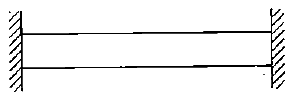A steel rod is rigidly clamped at its two ends. The rod is under zero tension at . If the temperature rises to , what force will the rod exert on one of the clapms? Area of cross section of the . Coefficient of linerar expansion of steel and Young's modulus of steel .
, theta_2= 100^@CA= 2 mm^2 = (2 xx (10^-6) (m^2)) (alpha_steel) = (12 xx 10^-6 /(^@C)Y_steel = (2 xx (10^11N))/(m^2)(F/A) / strain = Y F= (Y xx (Delta L))/ L xx A = (YL alpha Delta theta A) / L = ( YA alpha Delta theta) =2 xx 10^11 xx 2 xx 10^-6 xx 12 xx 10^-6 xx 80 = 48 xx 80 xx 10^-1 = 384N
Topper's Solved these Questions
- HEAT AND TEMPERATUREBOOK - HC VERMACHAPTER - HEAT AND TEMPERATUREEXERCISE - Exercise
4 Videos
- HEAT AND TEMPERATUREBOOK - HC VERMACHAPTER - HEAT AND TEMPERATUREEXERCISE - Objective 2
6 Videos
- GRAVITATIONBOOK - HC VERMACHAPTER - GRAVITATIONEXERCISE - Exercises
39 Videos
- HEAT TRANSFERBOOK - HC VERMACHAPTER - HEAT TRANSFEREXERCISE - EXERCIESE
1 Videos
Similar Questions
A steel ball initially at a pressure of 1.0×105Pa is heated from 200C to 1200C keeping its volume constant. Find the pressure inside the ball. Coefficient of linear expansion of steel =12×10−6^0C−1 and bulk modulus of steel =1.6×1011Nm−2
View SolutionA stell wire of cross-sectional area 0.5mm2 is held between teo fixed supports. If the wire is just taut at 20C, determine the tension when the temperature falls to 0C. Coefficient of linear expansion of steel is 1.2×10−50C(−1) and its Young's modulus is 2.0 xx 10^11 N m^(-2).
View Solution
Knowledge Check
The coefficient of linear expansion of a metal rod is 12×10−6/0C, its value in per ^(0)F
A203×10−6/0FB154×10−6/0FC21.6×10−6/0FD12×10−6/0FA steel wire of length 20 cm and uniform cross-section 1mm2 is tied rigidly at both the ends. If the temperature of the wire is altered from 40∘C to 20∘C, the change in tension. [Given coefficient of linear expansion of steel is 1.1×105.∘C−1 and Young's modulus for steel is 2.0×1011Nm−2]
A22 NB44 NC66 ND88 NA uniform rod of cross-section 4mm2 is heated from 0∘C to 10∘C. The coefficient of linear expansion of the rod, ∝=12×10−6/∘C and Young's modulus =1011N/m2. The strain produced in the rod is
A8×10−4B12×10−4C8×10−5D12×10−5
By how much amount should the temperature of a steel rod be increased so that its length increases by 0.5%? The coefficient of linear expansion of steel is 1.2×10−5C−1
View SolutionA steel wire of length 20 cm and unifrom crossection mm2 is tied rigidly at both the ends. If temperature of the wre is altered from 40∘C to 20∘C, calcutlate the change in tension. Given coeffeicient of linear expansion of steel is 1.1×10−5.∘C−1 and Young's modulus for steel is 2.0×1011Nm−2.
View SolutionA steel wire of uniform cross-sectional area 2mm2 is heated upto 50∘ and clamped rigidly at two ends . If the temperature of wire falls to 30∘ then change in tension in the wire will be , if coefficient of linear expansion of steel is 1.1×10−5/∘C and young's modulus of elasticity of steel is 2×1011N/m2
View SolutionFigure shows a steel rod of cross sectional ara 2×10−6m2 is fixed between two vertical walls. Initially at 20∘C there is no force between the ends of the rod and the walls. Find the force which the rod will exert on walls at 100∘C. Given that the coefficient of linear expansion of steel is 1.2×10−5.∘C−1 and Young's modulus is 2×1011N/m2

View SolutionA brass rod of length 50 cm and diameter 3.0 mm is joined to a steel rod of the same length and diameter. What is the change in length of the combined rod at 250∘C, if the original lengths are at 40.0∘C? Is there a 'thermal stress' developed at the junction ? The ends of the rod are free to expand. Coefficient of linear expansion of brass =2.0×10−5.∘C−1 and that of steel =1.2×10−5.∘C−1.
View Solution
